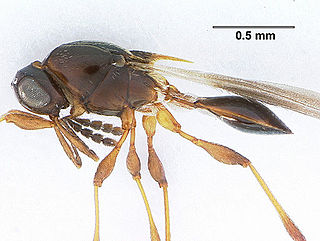
The Hymenopteran superfamily of parasitoid wasps, Platygastroidea, has often been treated as a lineage within the superfamily Proctotrupoidea, but most classifications since 1977 have recognized it as an independent group within the Proctotrupomorpha. It is presently has some 4000 described species. They are exclusively parasitic in nature.

The hymenopteran family Platygastridae is a large group of exclusively parasitoid wasps, mostly very small (1–2 mm), black, and shining, with geniculate (elbowed) antennae that have an eight-segmented flagellum. The wings sometimes lack venation, though they may have slight fringes of setae.
Anteris is a genus of wasps in the family Platygastridae. There are about 15 described species in Anteris.
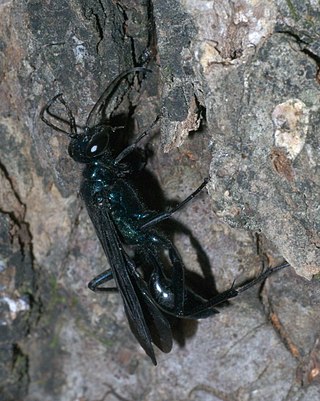
Sceliphrinae is a subfamily of thread-waisted wasps in the family Sphecidae. There are about 6 genera and at least 140 described species in Sceliphrinae.

Sphex nudus, the katydid wasp, is a species of thread-waisted wasp in the family Sphecidae.

Scelioninae is a subfamily of wasps in the family Platygastridae. It is a very large cosmopolitan group of exclusively parasitoid wasps, mostly small (0.5–10 mm), often black, often highly sculptured, usually with geniculate (elbowed) antennae that have a 9- or 10-segmented flagellum. It was formerly considered to be a family Scelionidae but has been reclassified as a subfamily of the Platygastridae.

Teleasinae is a subfamily of wasps in the family Platygastridae. There are about 14 genera and more than 250 species in Teleasinae.

Endelomyia aethiops, the roseslug, is a species of common sawfly in the family Tenthredinidae.

Pirenidae is a family of chalcidoid wasps. It was formerly treated as a subfamily within the family Pteromalidae but is now recognized as a distinct family.
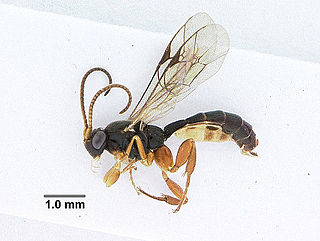
Orthocentrinae is a subfamily of ichneumon wasps in the family Ichneumonidae. There are about six genera in Orthocentrinae.

Rhyssinae is a subfamily of parasitoid wasps in the family Ichneumonidae. It contains eight genera and 259 described species, but there are likely many undiscovered species.

Rogas is a genus of braconid wasps in the family Braconidae. There are at least 100 described species in Rogas.

Trissolcus is a genus of parasitoid wasps in the family Platygastridae. There are at least 180 described species in Trissolcus. They parasitize eggs of Pentatomorpha.

Vespula vidua, known generally as the long yellowjacket or widow yellowjacket, is a species of stinging wasp in the family Vespidae.
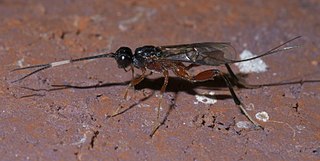
Helconinae is a subfamily of braconid wasps in the family Braconidae. This is a large subfamily with many changes to classification and included groups over the years. There are about 40 genera worldwide in this subfamily.

Haltichellinae is a subfamily of chalcidid wasps in the family Chalcididae.

Eucharitinae is a subfamily of chalcid wasps in the family Eucharitidae.

Lithurginae is a subfamily of woodborer bees in the family Megachilidae.
Tibicinini is a tribe of cicadas in the family Cicadidae. There are about 8 genera and at least 100 described species in Tibicinini, found in the Holarctic.
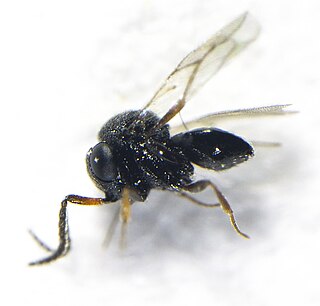
Trissolcus oenone is a parasitoid wasp in the family Platygastridae, native to Australia and New Zealand. It parasitises the eggs of stink bugs (Pentatomidae), but little is known about its biology.



















